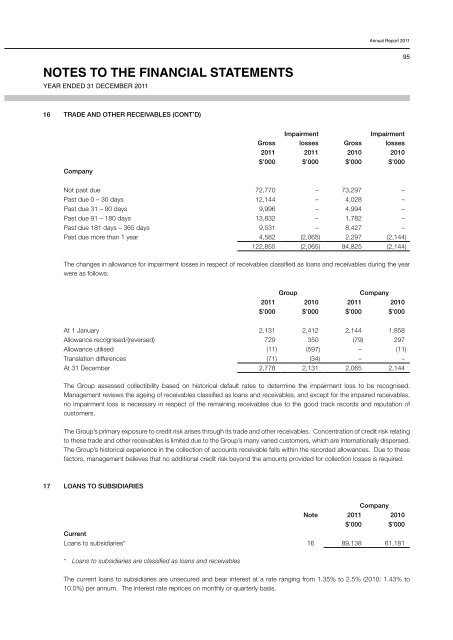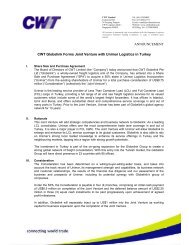notes to the financial statements - Investor Relations
notes to the financial statements - Investor Relations
notes to the financial statements - Investor Relations
Create successful ePaper yourself
Turn your PDF publications into a flip-book with our unique Google optimized e-Paper software.
NOTES TO THE FINANCIAL STATEMENTS<br />
YEAR ENDED 31 DECEMBER 2011<br />
16 TRADE AND OTHER RECEIVABLES (CONT’D)<br />
Company<br />
Gross<br />
Impairment<br />
losses Gross<br />
Annual Report 2011<br />
Impairment<br />
losses<br />
2011 2011 2010 2010<br />
$’000 $’000 $’000 $’000<br />
Not past due 72,770 – 73,297 –<br />
Past due 0 – 30 days 12,144 – 4,028 –<br />
Past due 31 – 90 days 9,996 – 4,994 –<br />
Past due 91 – 180 days 13,832 – 1,782 –<br />
Past due 181 days – 365 days 9,531 – 8,427 –<br />
Past due more than 1 year 4,582 (2,065) 2,297 (2,144)<br />
122,855 (2,065) 94,825 (2,144)<br />
The changes in allowance for impairment losses in respect of receivables classified as loans and receivables during <strong>the</strong> year<br />
were as follows:<br />
Group Company<br />
2011 2010 2011 2010<br />
$’000 $’000 $’000 $’000<br />
At 1 January 2,131 2,412 2,144 1,858<br />
Allowance recognised/(reversed) 729 350 (79) 297<br />
Allowance utilised (11) (597) – (11)<br />
Translation differences (71) (34) – –<br />
At 31 December 2,778 2,131 2,065 2,144<br />
The Group assessed collectibility based on his<strong>to</strong>rical default rates <strong>to</strong> determine <strong>the</strong> impairment loss <strong>to</strong> be recognised.<br />
Management reviews <strong>the</strong> ageing of receivables classified as loans and receivables, and except for <strong>the</strong> impaired receivables,<br />
no impairment loss is necessary in respect of <strong>the</strong> remaining receivables due <strong>to</strong> <strong>the</strong> good track records and reputation of<br />
cus<strong>to</strong>mers.<br />
The Group’s primary exposure <strong>to</strong> credit risk arises through its trade and o<strong>the</strong>r receivables. Concentration of credit risk relating<br />
<strong>to</strong> <strong>the</strong>se trade and o<strong>the</strong>r receivables is limited due <strong>to</strong> <strong>the</strong> Group’s many varied cus<strong>to</strong>mers, which are internationally dispersed.<br />
The Group’s his<strong>to</strong>rical experience in <strong>the</strong> collection of accounts receivable falls within <strong>the</strong> recorded allowances. Due <strong>to</strong> <strong>the</strong>se<br />
fac<strong>to</strong>rs, management believes that no additional credit risk beyond <strong>the</strong> amounts provided for collection losses is required.<br />
17 LOANS TO SUBSIDIARIES<br />
Note<br />
Company<br />
2011 2010<br />
$’000 $’000<br />
Current<br />
Loans <strong>to</strong> subsidiaries* 16 89,138 61,181<br />
* Loans <strong>to</strong> subsidiaries are classified as loans and receivables<br />
The current loans <strong>to</strong> subsidiaries are unsecured and bear interest at a rate ranging from 1.35% <strong>to</strong> 2.5% (2010: 1.43% <strong>to</strong><br />
10.0%) per annum. The interest rate reprices on monthly or quarterly basis.<br />
95





